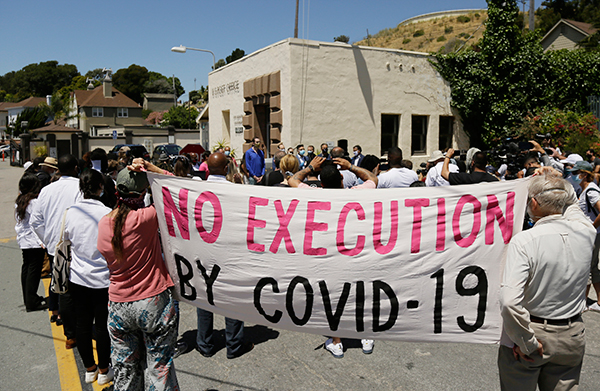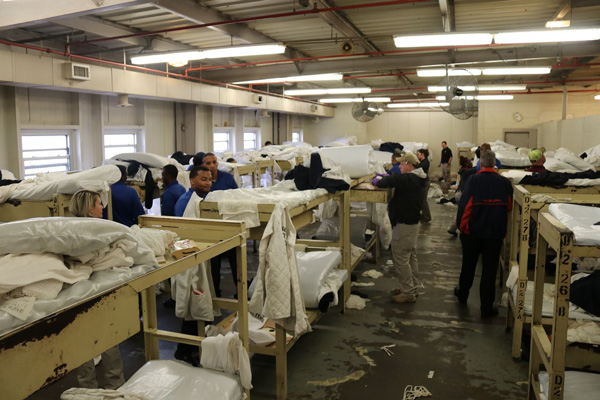From a Reader:
COVID-19 Catastrophe Inside U.S. Prisons and Jails
| revcom.us
The past month has seen the COVID-19 crisis careen out of control across the country. The infection rate—and the death rate—continue to reach new highs by the day, with no end in sight. This spreading pandemic is striking with even greater terror the more than two million men and women held in the 6,000 jails and prisons across the country. Mass incarceration has made going to jail a possible death sentence for any crime.
The number of coronavirus infections reported among state and federal prisoners had reached 197,659 by November 17, with record-high spikes for each of the previous two weeks, according to the Marshall Project.1 More than 1,450 prisoners have died. These rates of sickness among inmates are more than four times as high as those of the general public; the death rate is more than twice as high. These figures do not include the more than 500,000 people being held in city and county jails across the country. The real numbers are even higher, since the spread of the virus into surrounding communities isn’t measured.
Texas has the largest number of state prisoners with 141,661, and has seen more deaths and infections from COVID-19 than any other state, based on a new report from researchers at the University of Texas at Austin. The rate of infection in Texas prisons is nearly 500 percent higher than in the overall statewide population, and 620 percent higher than the national average. In California, over the summer San Quentin State Prison experienced “the worst epidemiological disaster in that state’s prison history.”2
There is no escape from the coronavirus inside the prisons, which act as hothouses for the disease. The cramped, overcrowded, often poorly ventilated conditions make it impossible for prisoners to avoid exposure. The lack of adequate safety equipment, inconsistent cleaning, irregular testing, inadequate medical resources, and the constant in-and-out of staff, visitors, and prisoners increases the danger. Added to that, those incarcerated have higher rates of pre-existing health problems: high blood pressure, asthma, diabetes, and heart disease, raising the risk of complications and death.
At the end of April, eight of the 10 top coronavirus hotspots in the country were prisons or jails. Prisoners began rebelling against and resisting the “death by COVID” conditions: seizing cellblocks, organizing hunger strikes, clashing with guards because of lack of soap and masks, and more.3 Pressure mounted to reduce prison populations by releasing those serving nonviolent sentences, older prisoners who’d already spent decades behind bars, and those not charged with a crime. The authorities made a big show of releasing a few (far less than other countries), while the vast majority continued to be held. But the numbers began to rise again over the summer, and by mid-August, the Association of American Medical Colleges reported that only 11 of the 100 top COVID-19 clusters in the U.S. were not in a jail or prison.
Mass Incarceration and Genocide
America is known worldwide for its mass incarceration.4 There are more people imprisoned in this country than in any other country in the world. This is true for women as well as men. According to the Brennan Center for Justice,5 the U.S. incarceration rate is nine times higher than in Germany, eight times higher than in Italy, five times higher than in the U.K., and 15 times higher than in Japan. For four decades the “war on drugs” has been used for the mass incarceration of Black and Latino people. Between 1980 and 2018, imprisonment for drugs rose from 40,900 to 443,200, resulting in a national prison population today that is 60 percent Black and Latino, far greater than their portion of the country’s population overall.6 In California, Black people constitute six percent of state residents, but 20 percent of people in jail and 28 percent of people in prison.
The Brennan Center has calculated that, of the 1.46 million people in state and federal prisons in 2016, 576,000, or 39 percent, were in prison without any public safety reason! And the American Bar Association found before the pandemic that as many as 500,000 people (again disproportionately Black and other oppressed people) were being held across the country in local jails mostly for low-level offenses only because they can’t pay bail. And still, with the COVID-19 pandemic rampaging through the country’s prisons and jails today, the authorities are making no serious moves to release those hundreds of thousands being imprisoned “who pose no public safety reason,” nor to provide the remainder with the necessary social distancing, safety equipment, cleaning supplies, and proper medical care fit for human beings. Instead the coronavirus is being used to speed up the “slow genocide” of mass incarceration into a fast one!
***
See these articles from revcom.us:
2.3 Million U.S. Prisoners and Detainees Trapped in “Petri Dish” for Coronavirus, revcom.us, updated April 6, 2020
Prisoners Write, Exposing Conditions Under COVID-19 Pandemic in America’s Hellholes, revcom.us, April 6, 2020
Prisoners Write on Coronavirus Pandemic—
“the crisis brought about by Covid-19 is bringing to light the sharp contradictions of this Capitalism/Imperialist system”, revcom.us, May 18, 2020
“When will this end? We need a dramatic change now!”, revcom.us, from a prisoner in Louisiana, September 2020
Prisoners Resist Outrageous “Death From COVID” Sentences, revcom.us, April 13, 2020
1. Since March, The Marshall Project has been tracking how many people are being sickened and killed by COVID-19 in prisons and how widely it has spread across the country and within each state. [back]
2. Until the end of May, San Quentin State Prison, north of San Francisco, had zero inmate infections, despite being 168 years old, with terrible ventilation and sanitation, double cells and close quarters. Then, on May 30, 121 men were transferred from the overcrowded Chino State Prison, which was facing a surge of cases. By July 4, more than a third of the inmates at San Quentin had been infected and tested positive for COVID-19. By September 25, the 27th prisoner had died. In October, a Court of Appeal ruled in favor of a prisoner who had filed a lawsuit, calling what happened “morally indefensible and constitutionally untenable,” and ordered San Quentin to immediately cut the number of prisoners to half what it had been in June. [back]
3. “Prisoners Resist Outrageous ‘Death From COVID’ Sentences,” revcom.us, April 13, 2020. [back]
4. “Sentencing policies of the War on Drugs era resulted in dramatic growth in incarceration for drug offenses. Since its official beginning in the 1980s, the number of Americans incarcerated for drug offenses has skyrocketed from 40,900 in 1980 to 443,200 in 2018. Furthermore, harsh sentencing laws such as mandatory minimums keep many people convicted of drug offenses in prison for longer periods of time: in 1986, people released after serving time for a federal drug offense had spent an average of 22 months in prison. By 2004, people convicted on federal drug offenses were expected to serve almost three times that length: 62 months in prison.” The Sentencing Project. [back]
5. The American criminal justice system holds almost 2.3 million people in 1,833 state prisons, 110 federal prisons, 1,772 juvenile correctional facilities, 3,134 local jails, 218 immigration detention facilities, and 80 Indian Country jails as well as in military prisons, civil commitment centers, state psychiatric hospitals, and prisons in the U.S. Territories. (Prison Policy Initiative) [back]
6. The Sentencing Project. [back]

By the end of July, there were at least 2,159 confirmed cases of Covid-19 at San Quentin and 19 deaths. Relatives and friends protest "execution by COVID 19." (Photo: AP)

Prisoners in close quarters at Alabama's Easterling Correctional Facility, February 25, 2020. (Alabama Department of Corrections)
Get a free email subscription to revcom.us:

